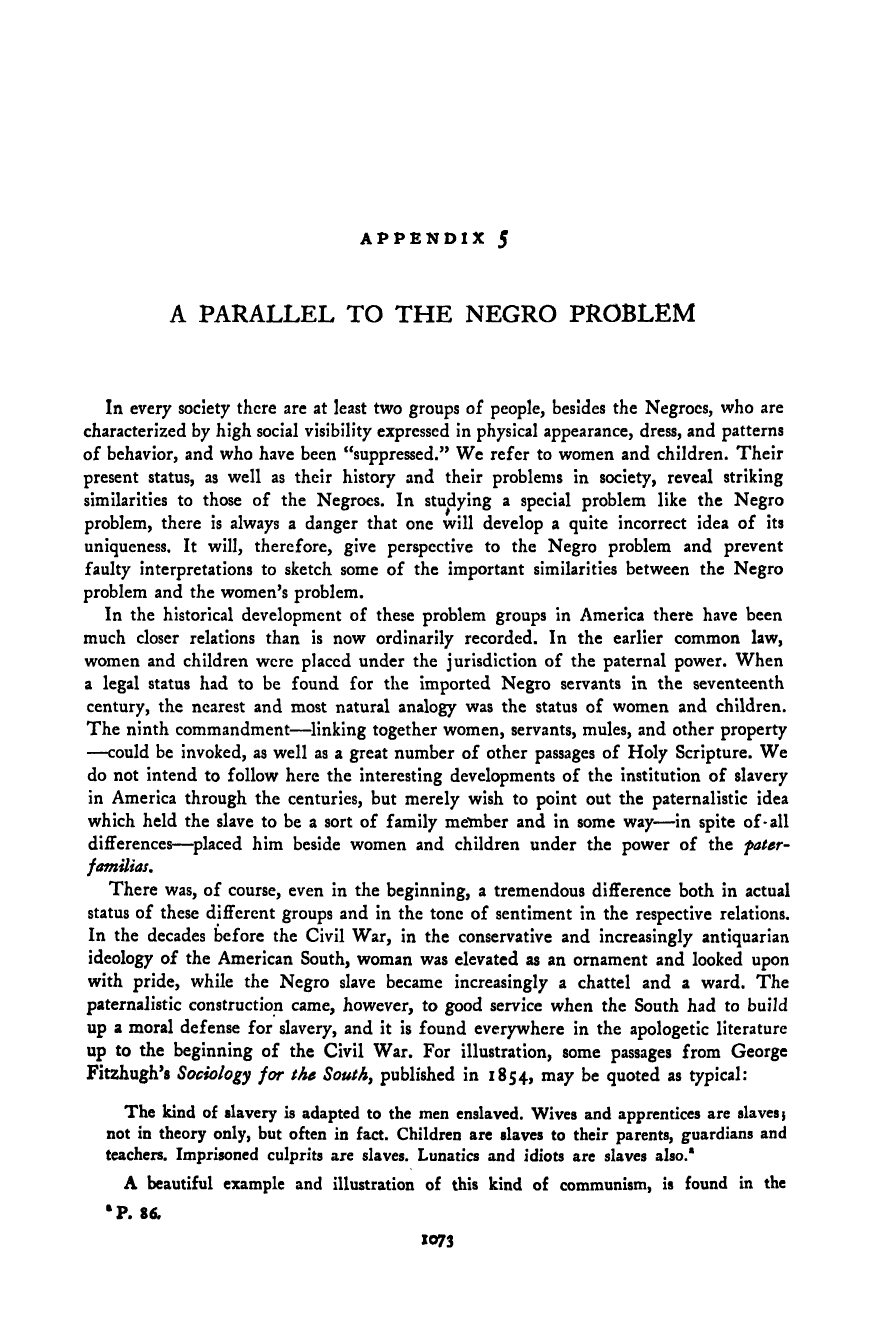Note: Gunnar Myrdal died in 1987, less than 70 years ago. Therefore, this work is protected by copyright, restricting your legal rights to reproduce it. However, you are welcome to view it on screen, as you do now. Read more about copyright.
Full resolution (TIFF) - On this page / på denna sida - Appendices - 5. A Parallel to the Negro Problem

<< prev. page << föreg. sida << >> nästa sida >> next page >>
Below is the raw OCR text
from the above scanned image.
Do you see an error? Proofread the page now!
Här nedan syns maskintolkade texten från faksimilbilden ovan.
Ser du något fel? Korrekturläs sidan nu!
This page has never been proofread. / Denna sida har aldrig korrekturlästs.
APPENDIX 5
A PARALLEL TO THE NEGRO PROBLEM
In every society there are at least two groups of people, besides the Negroes, who are
characterized by high social visibility expressed in physical appearance, dress, and patterns
of behavior, and who have been ‘‘suppressed.” We refer to women and children. Their
present status, as well as their history and their problems in society, reveal striking
similarities to those of the Negroes. In studying a special problem like the Negro
problem, there is always a danger that one will develop a quite incorrect idea of its
uniqueness. It will, therefore, give perspective to the Negro problem and prevent
faulty interpretations to sketch some of the important similarities between the Negro
problem and the women’s problem.
In the historical development of these problem groups in America there have been
much closer relations than is now ordinarily recorded. In the earlier common law,
women and children were placed under the jurisdiction of the paternal power. When
a legal status had to be found for the imported Negro servants in the seventeenth
century, the nearest and most natural analogy was the status of women and children.
The ninth commandment—blinking together women, servants, mules, and other property
—could be invoked, as well as a great number of other passages of Holy Scripture. We
do not intend to follow here the interesting developments of the institution of slavery
in America through the centuries, but merely wish to point out the paternalistic idea
which held the slave to be a sort of family member and in some way—in spite of* all
differences—^placed him beside women and children under the power of the fatcr-
familias.
There was, of course, even in the beginning, a tremendous difference both in actual
status of these different groups and in the tone of sentiment in the respective relations.
In the decades before the Civil War, in the conservative and increasingly antiquarian
ideology of the American South, woman was elevated as an ornament and looked upon
with pride, while the Negro slave became increasingly a chattel and a ward. The
paternalistic construction came, however, to good service when the South had to build
up a moral defense for slavery, and it is found everywhere in the apologetic literature
up to the beginning of the Civil War. For illustration, some passages from George
Fitzhugh’s Sociology for the Souths published in 1854, may be quoted as typical:
The kind of slavery is adapted to the men enslaved. Wives and apprentices are slaves j
not in theory only, but often in fact. Children are slaves to their parents, guardians and
teachers. Imprisoned culprits are slaves. Lunatics and idiots are slaves also.*
A beautiful example and illustration of this kind of communism, is found in the
•P. 86.
1073
<< prev. page << föreg. sida << >> nästa sida >> next page >>